“Is What We See Always Real?” A Comparative Study of Two-Dimensional and Three-Dimensional Urban Green Spaces: The Case of Shenzhen’s Central District
Abstract
:1. Introduction
2. Study Area and Data
2.1. Overview of the Study Area
2.2. Data Source and Data Preprocessing
2.2.1. Various Data Sources and Related Software Versions
2.2.2. Administrative Divisions and Road Data
2.2.3. NDVI and Street View Image Data
3. Research Methodology
3.1. Analytical Framework
3.2. NDVI Calculation
3.3. GVI Calculation
3.3.1. GVI Recognition Based on Image Semantic Segmentation Neural Network
3.3.2. Minimizing Deformation Error
3.3.3. Reasons for the Null Value of GVI Data
4. Results and Discussion
4.1. Overall Characteristics of Street Green Spaces
4.1.1. In Three-Dimensional Space, the Road Greening Levels in Shenzhen’s Nanshan, Futian, and Luohu Districts Are Overall High
4.1.2. In Two-Dimensional Space, Urban and Forest Parks Form the Backbone, with Road Greening Connecting to Form a Green Ecological Network
4.2. Correlation Analysis between Two-Dimensional and Three-Dimensional Street Green Space
4.3. Analysis of the Causes of Differences
4.3.1. Areas with High NDVI and GVI and Their Main Causes
4.3.2. Areas with Low NDVI and GVI and Their Main Causes
4.3.3. Areas with High NDVI but Low GVI and Their Main Causes
4.3.4. Areas with Low NDVI and High GVI and Their Main Causes
4.4. Discussion
5. Conclusions
5.1. Main Findings
5.1.1. Shenzhen’s Core Area Has Good Green Infrastructure Construction
5.1.2. Moderate Correlation between 2D and 3D Greening Data
5.1.3. Four Classification Relationships between 2D and 3D Greening Data
5.1.4. The Limitation of the Sampler’s Perspective Is the Main Cause of Differences between 2D and 3D Green Space Data
5.1.5. Using GVI as a Substitute for NDVI Null Values Can Reduce Greening Assessment Errors
5.2. Limitations
Author Contributions
Funding
Data Availability Statement
Conflicts of Interest
References
- National Bureau of Statistics of China. Annual Data of Major Economic Indicators of China. National Bureau of Statistics of China. 2024. Available online: https://data.stats.gov.cn/easyquery.htm?cn=C01 (accessed on 9 December 2023).
- Chen, Y.; Qiao, Y.; Yan, P.; Lu, H.; Yang, L.; Xia, J. Spatial-temporal variation and nonlinear prediction of environmental footprints and comprehensive environmental pressure in urban agglomerations. J. Clean. Prod. 2022, 351, 131556. [Google Scholar] [CrossRef]
- Liang, L.; Chen, M.; Lu, D. Revisiting the relationship between urbanization and economic development in China since the reform and opening-up. Chin. Geogr. Sci. 2022, 32, 1–15. [Google Scholar] [CrossRef]
- Herzog, T.R.; Gale, T.A. Preference for urban buildings as a function of age and nature context. Environ. Behav. 1996, 28, 44–72. [Google Scholar] [CrossRef]
- Gao, M.; Ahern, J.A.; Koshland, C.P. Perceived built environment and health-related quality of life in four types of neighborhoods in Xi’an, China. Health Place 2016, 39, 110–115. [Google Scholar] [CrossRef]
- Liu, Y.; Li, H.; Li, W.; Wang, S. Renovation priorities for old residential districts based on resident satisfaction: An application of asymmetric impact-performance analysis in Xi’an, China. PLoS ONE 2021, 16, e0254372. [Google Scholar] [CrossRef] [PubMed]
- Bahrainy, H.; Khosravi, H. The impact of urban design features and qualities on walkability and health in under-construction environments: The case of Hashtgerd New Town in Iran. Cities 2013, 31, 17–28. [Google Scholar] [CrossRef]
- Ji, J.S.; Chen, R.; Zhao, B. Megacity, Microscale Livable Space, and Major Depression. JAMA Netw. Open 2021, 4, e2130941. [Google Scholar] [CrossRef]
- Zeng, P.; Wei, X.; Duan, Z. Coupling and coordination analysis in urban agglomerations of China: Urbanization and ecological security perspectives. J. Clean. Prod. 2022, 365, 132730. [Google Scholar] [CrossRef]
- Zamparas, M.; Kyriakopoulos, G.L.; Drosos, M.; Kapsalis, V.C.; Kalavrouziotis, I.K. Novel composite materials for lake restoration: A new approach impacting on ecology and circular economy. Sustainability 2020, 12, 3397. [Google Scholar] [CrossRef]
- Kondo, M.C.; Fluehr, J.M.; McKeon, T.; Branas, C.C. Urban green space and its impact on human health. Int. J. Environ. Res. Public Health 2018, 15, 445. [Google Scholar] [CrossRef]
- Gao, Z.; Zaitchik, B.F.; Hou, Y.; Chen, W. Toward park design optimization to mitigate the urban heat Island: Assessment of the cooling effect in five US cities. Sustain. Cities Soc. 2022, 81, 103870. [Google Scholar] [CrossRef]
- Norton, B.A.; Coutts, A.M.; Livesley, S.J.; Harris, R.J.; Hunter, A.M.; Williams, N.S.G. Planning for cooler cities: A framework to prioritise green infrastructure to mitigate high temperatures in urban landscapes. Landsc. Urban Plan. 2015, 134, 127–138. [Google Scholar] [CrossRef]
- Farinmade, A.; Soyinka, O.; Siu, K.W.M. Assessing the effect of urban informal economic activity on the quality of the built environment for sustainable urban development in Lagos, Nigeria. Sustain. Cities Soc. 2018, 41, 13–21. [Google Scholar] [CrossRef]
- Sharifi, A. Co-benefits and synergies between urban climate change mitigation and adaptation measures: A literature review. Sci. Total Environ. 2021, 750, 141642. [Google Scholar] [CrossRef] [PubMed]
- Meerow, S.; Newell, J.P.; Stults, M. Defining urban resilience: A review. Landsc. Urban Plan. 2016, 147, 38–49. [Google Scholar] [CrossRef]
- Lu, Y.; Sarkar, C.; Xiao, Y. The effect of street-level greenery on walking behavior: Evidence from Hong Kong. Soc. Sci. Med. 2018, 208, 41–49. [Google Scholar] [CrossRef] [PubMed]
- Wolf, K.L. Business district streetscapes, trees, and consumer response. J. For. 2005, 103, 396–400. [Google Scholar] [CrossRef]
- Helbich, M.; Yao, Y.; Liu, Y.; Zhang, J.; Liu, P.; Wang, R. Using deep learning to examine street view green and blue spaces and their associations with geriatric depression in Beijing, China. Environ. Int. 2019, 126, 107–117. [Google Scholar] [CrossRef]
- Bell, S. Health and well-being aspects of urban blue space: The new urban landscape research field. Landsc. Archit. 2019, 26, 119–131. [Google Scholar]
- Aoki, Y. Relationship between perceived greenery and width of visual fields. J. Jpn. Inst. Landsc. Arch. 1987, 51, 1–10. [Google Scholar]
- Catania, J.A.; McDermott, L.J.; Pollack, L.M. Questionnaire response bias and face-to-face interview sample bias in sexuality research. J. Sex Res. 1986, 22, 52–72. [Google Scholar] [CrossRef]
- Li, X.; Zhang, C.; Li, W.; Ricard, R.; Meng, Q.; Zhang, W. Assessing street-level urban greenery using Google Street View and a modified green view index. Urban For. Urban Green. 2015, 14, 675–685. [Google Scholar] [CrossRef]
- Lu, Y. The association of urban greenness and walking behavior: Using google street view and deep learning techniques to estimate residents’ exposure to urban greenness. Int. J. Environ. Res. Public Health 2018, 15, 1576. [Google Scholar] [CrossRef] [PubMed]
- Kameoka, T.; Uchida, A.; Sasaki, Y.; Ise, T. Assessing streetscape greenery with deep neural network using Google Street View. Breed. Sci. 2022, 72, 107–114. [Google Scholar] [CrossRef] [PubMed]
- Chiang, Y.C.; Liu, H.H.; Li, D.; Ho, L.C. Quantification through deep learning of sky view factor and greenery on urban streets during hot and cool seasons. Landsc. Urban Plan. 2023, 232, 104679. [Google Scholar] [CrossRef]
- Shenzhen Bureau of Statistics. Shenzhen Statistical Yearbook 2023. National Bureau of Statistics of China. 2024. Available online: https://tjj.sz.gov.cn/gkmlpt/content/11/11182/post_11182604.html#4219 (accessed on 12 April 2024).
- Goldblatt, R.; Stuhlmacher, M.F.; Tellman, B.; Clinton, N.; Hanson, G.; Georgescu, M.; Wang, C.; Serrano-Candela, F.; Khandelwal, A.K.; Cheng, W.H.; et al. Using Landsat and nighttime lights for supervised pixel-based image classification of urban land cover. Remote Sens. Environ. 2018, 205, 253–275. [Google Scholar] [CrossRef]
- Yao, Y.; Liang, Z.; Yuan, Z.; Liu, P.; Bie, Y.; Zhang, J.; Wang, R.; Wang, J.; Guan, Q. A human-machine adversarial scoring framework for urban perception assessment using street-view images. Int. J. Geogr. Inf. Sci. 2019, 33, 2363–2384. [Google Scholar] [CrossRef]
- Zeiler, M.D.; Fergus, R. Visualizing and understanding convolutional networks. In Proceedings of the European Conference on Computer Vision, Zurich, Switzerland, 6–12 September 2014; pp. 818–833. [Google Scholar]
- Cordts, M.; Omran, M.; Ramos, S.; Rehfeld, T.; Enzweiler, M.; Benenson, R.; Franke, U.; Roth, S.; Schiele, B. The Cityscapes Dataset for semantic urban scene understanding. In Proceedings of the 2016 IEEE Conference on Computer Vision and Pattern Recognition (CVPR), Las Vegas, NV, USA, 27–30 June 2016; pp. 3213–3223. [Google Scholar]
- Du, S.; Liu, B.; Zhang, X. Incorporating DeepLabv3+ and object-based image analysis for semantic segmentation of very high resolution remote sensing images. Int. J. Digit. Earth 2021, 14, 357–378. [Google Scholar] [CrossRef]
- Chen, L.C.; Zhu, Y.; Papandreou, G.; Schroff, F.; Adam, H. Encoder-decoder with atrous separable convolution for semantic image segmentation. In Proceedings of the European Conference on Computer Vision (ECCV) 2018, Munich, Germany, 8–14 September 2018; pp. 801–818. [Google Scholar]
- Chen, L.C.; Papandreou, G.; Kokkinos, I.; Murphy, K.; Yuille, A.L. Semantic image segmentation with deep convolutional nets and fully connected CRFs. arXiv 2014, arXiv:1412.7062. [Google Scholar]
- Yin, L.; Cheng, Q.; Wang, Z.; Shao, Z. ‘Big data’ for pedestrian volume: Exploring the use of Google Street View images for pedestrian counts. Appl. Geogr. 2015, 63, 337–345. [Google Scholar] [CrossRef]
- Ye, Y.; Richards, D.; Lu, Y.; Song, X.; Zhuang, Y.; Zeng, W.; Zhong, T. Measuring daily accessed street greenery: A human-scale approach for informing better urban planning practices. Landsc. Urban Plan. 2019, 191, 103434. [Google Scholar] [CrossRef]
- Chao, L.; Zhang, K.; Li, Z.; Zhu, Y.; Wang, J.; Yu, Z. Geographically weighted regression based methods for merging satellite and gauge precipitation. J. Hydrol. 2018, 558, 275–289. [Google Scholar] [CrossRef]
- Wang, X.; Jiang, D.; Ma, D. Spatial auto-correlation analysis of vegetation cover using MODIS NDVI time series data: Regional comparison of Shandong Peninsula and Liaodong Peninsula. J. Arid Land Resour. Environ. 2013, 27, 139–144. [Google Scholar]
- Li, M.; Hou, X.; Ying, L.; Lu, X.; Zhu, M. Spatial-temporal dynamics of NDVI and its response to temperature and precipitation in the Yellow River Delta during the period 1998–2008. Resour. Sci. 2011, 33, 322–327. [Google Scholar]
- Sicard, P.; Agathokleous, E.; Anenberg, S.C.; De Marco, A.; Paoletti, E.; Calatayud, V. Trends in urban air pollution over the last two decades: A global perspective. Sci. Total Environ. 2023, 858, 160064. [Google Scholar] [CrossRef] [PubMed]
- Bai, Y.; Shang, C.; Li, Y.; Shen, L.; Jin, S.; Shen, Q. Transport object detection in street view imagery using decomposed convolutional neural networks. Mathematics 2023, 11, 3839. [Google Scholar] [CrossRef]
- Huang, S.; Tang, L.; Hupy, J.P.; Wang, Y.; Shao, G. A commentary review on the use of normalized difference vegetation index (NDVI) in the era of popular remote sensing. J. For. Res. 2021, 32, 1–6. [Google Scholar] [CrossRef]
- Calota, I.; Faur, D.; Datcu, M. Estimating NDVI from SAR Images Using DNN. In Proceedings of the IGARSS 2022—2022 IEEE International Geoscience and Remote Sensing Symposium 2022, Kuala Lumpur, Malaysia, 17–22 July 2022; pp. 5232–5235. [Google Scholar]
- Rao, Y.; Zhu, X.; Chen, J.; Wang, J. An Improved Method for Producing High Spatial-Resolution NDVI Time Series Datasets with Multi-Temporal MODIS NDVI Data and Landsat TM/ETM+ Images. Remote Sens. 2015, 7, 7865–7891. [Google Scholar] [CrossRef]
- Xu, C.; Ding, A.; Zhao, K. A novel POI recommendation method based on trust relationship and spatial-temporal factors. Electron. Commer. Res. Appl. 2021, 48, 101060. [Google Scholar]
- Zhou, M.; Wang, M.; Hu, Q. A POI data update approach based on Weibo check-in data. In Proceedings of the 2013 21st International Conference on Geoinformatics 2013, Kaifeng, China, 20–22 June 2013; pp. 1–4. [Google Scholar]
- Huang, Q.; Yang, Y.; Xu, Y.; Yang, F.; Yuan, Z.; Sun, Y. Citywide road-network traffic monitoring using large-scale mobile signaling data. Neurocomputing 2021, 444, 136–146. [Google Scholar] [CrossRef]
- Xu, Y.; Li, X.; Shaw, S.; Lu, F.; Yin, L.; Chen, B. Effects of Data Preprocessing Methods on Addressing Location Uncertainty in Mobile Signaling Data. Ann. Am. Assoc. Geogr. 2020, 111, 515–539. [Google Scholar] [CrossRef]
- Gang, H.; Fu, L.; Liu, C.; Shen, Z. Using Massive Mobile Signaling to Monitor the Highway Traffic. In Signal and Information Processing, Networking and Computers, Proceedings of the 4th International Conference on Signal and Information Processing, Networking and Computers (ICSINC), Qingdao, China, 23–25 May 2019; Springer: Singapore, 2019; pp. 221–228. [Google Scholar]
- Li, F.; Han, L.; Zhu, L.; Huang, Y.; Song, G. Urban vegetation mapping based on the hj-1 ndvi reconstruction. ISPRS-Int. Arch. Photogramm. Remote Sens. Spat. Inf. Sci. 2016, 41, 867–871. [Google Scholar] [CrossRef]
- Martinez, A.; Labib, S. Demystifying normalized difference vegetation index (NDVI) for greenness exposure assessments and policy interventions in urban greening. Environ. Res. 2022, 220, 115155. [Google Scholar] [CrossRef] [PubMed]



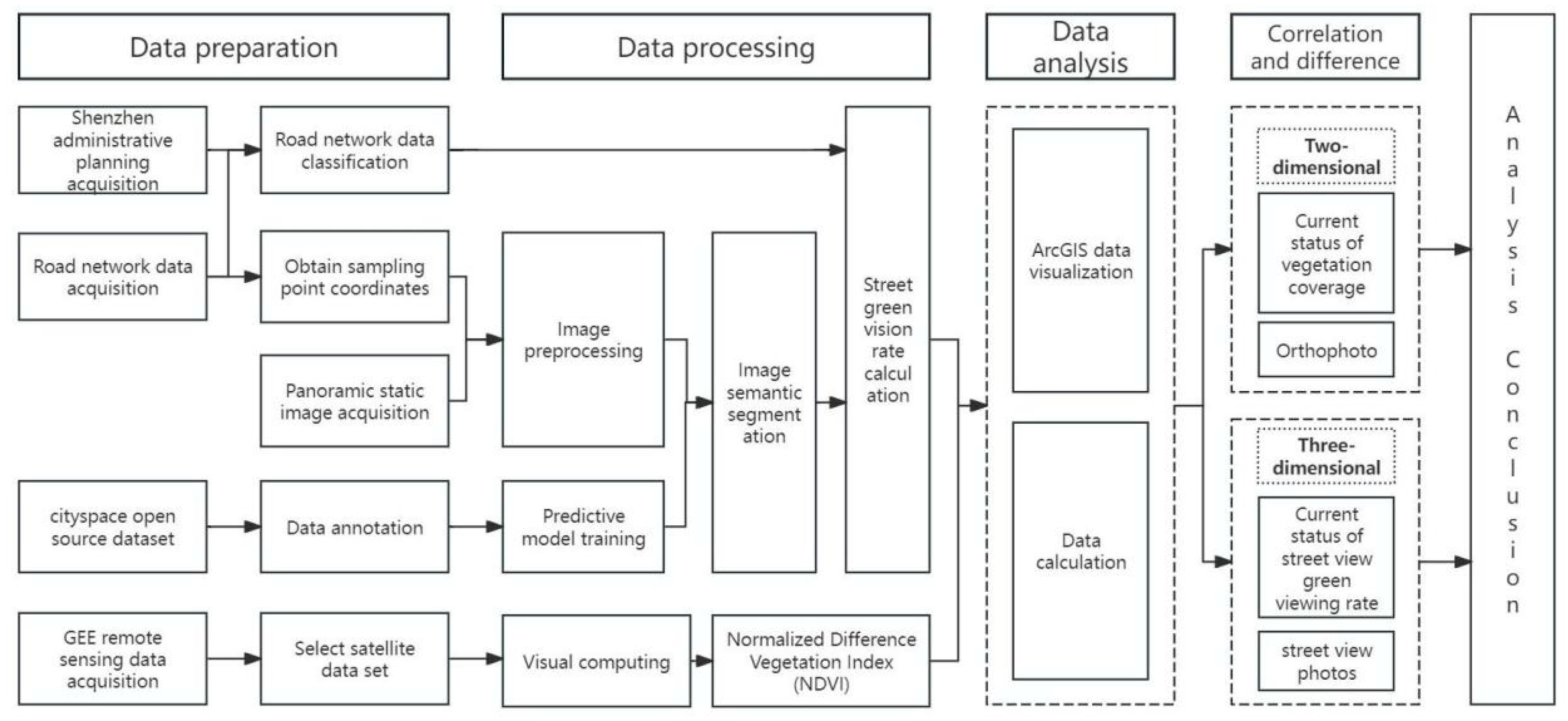

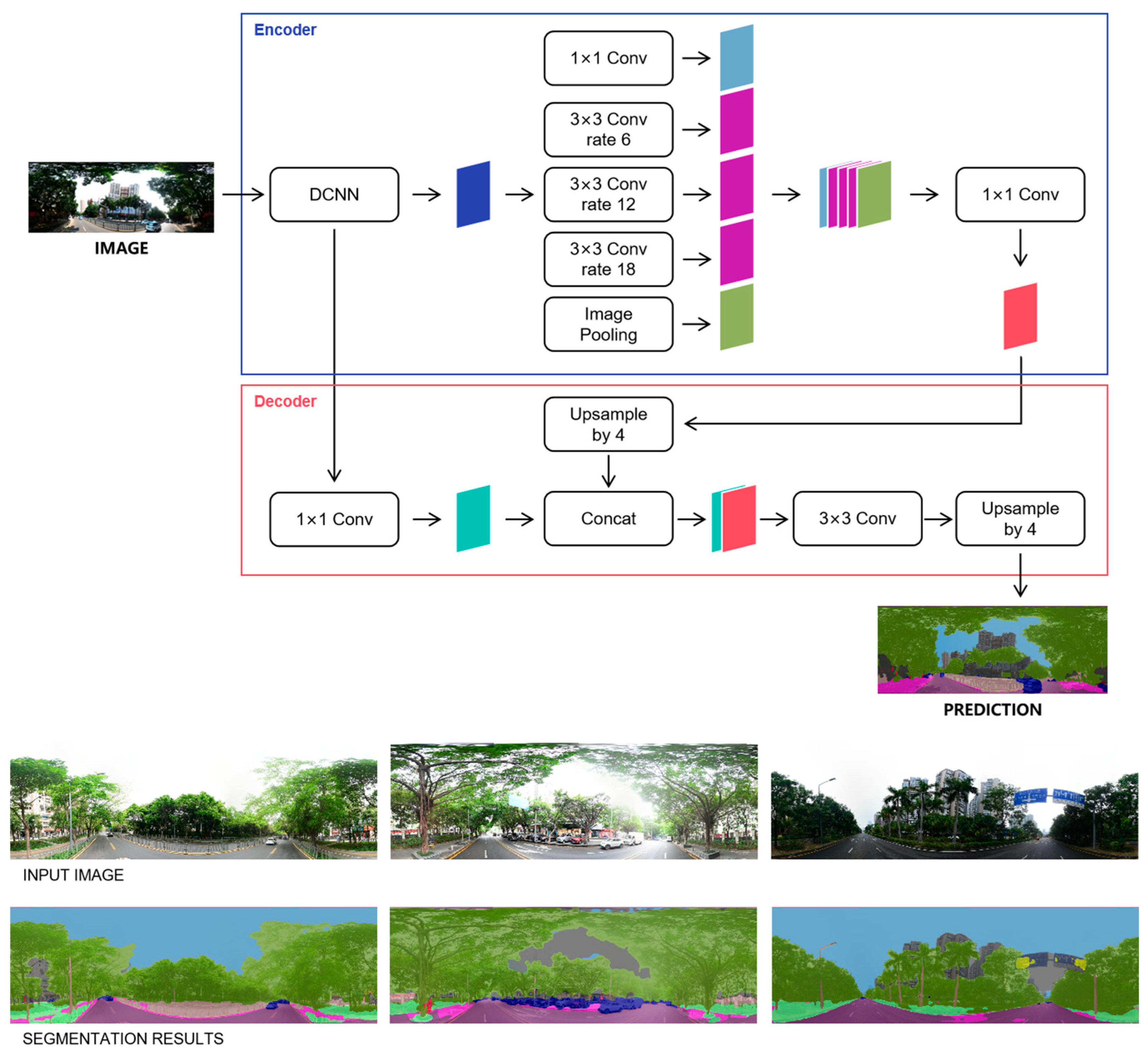
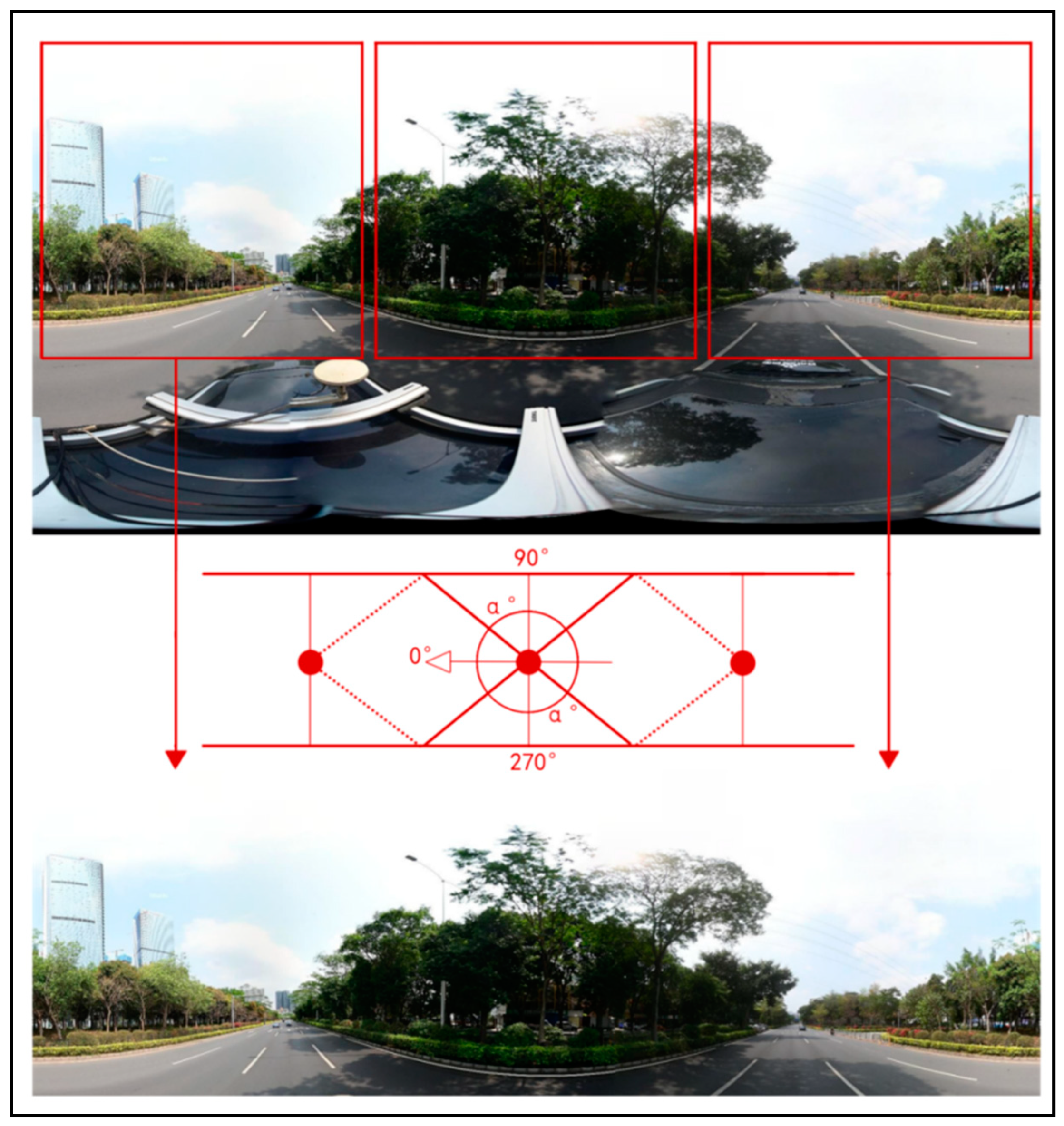







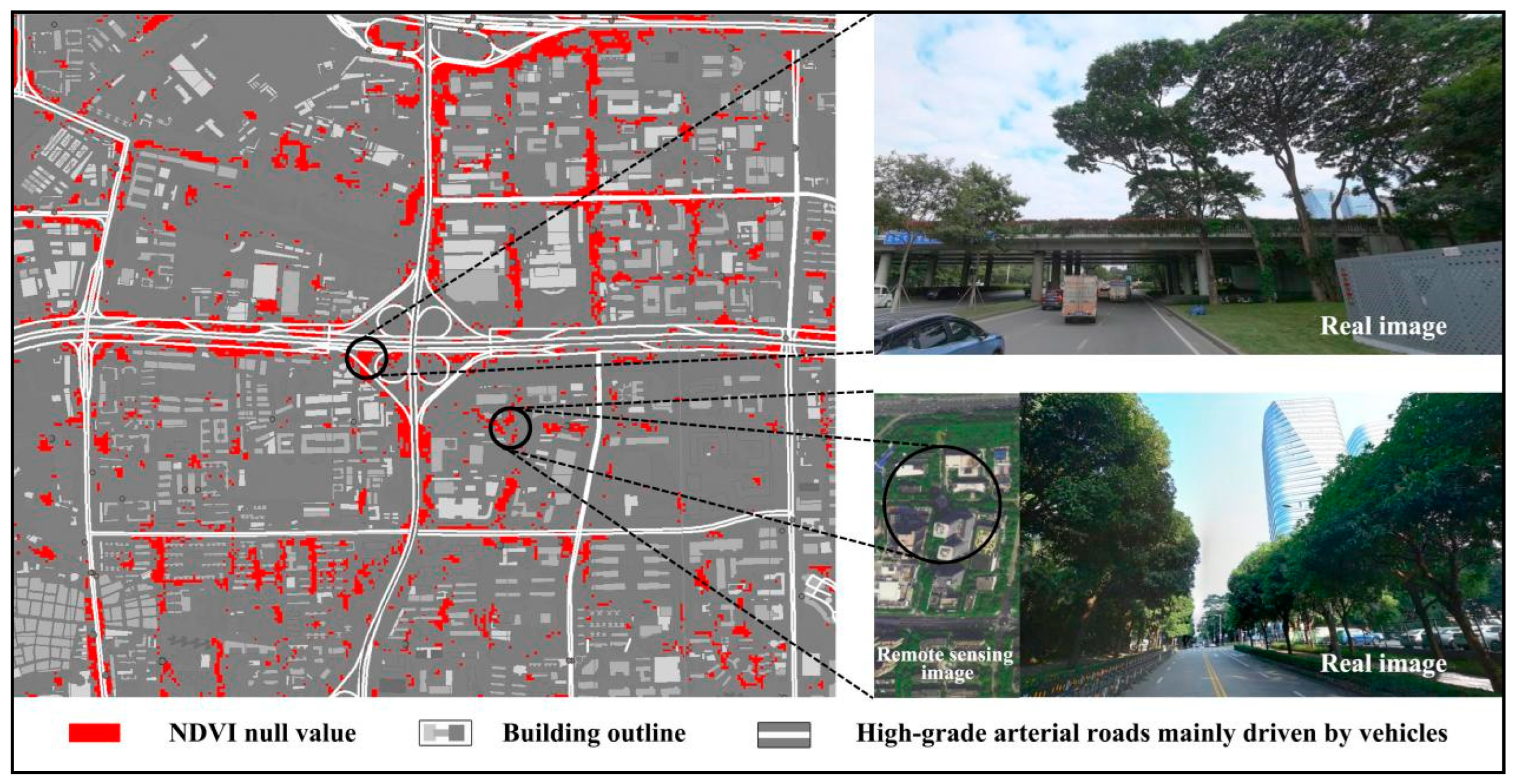
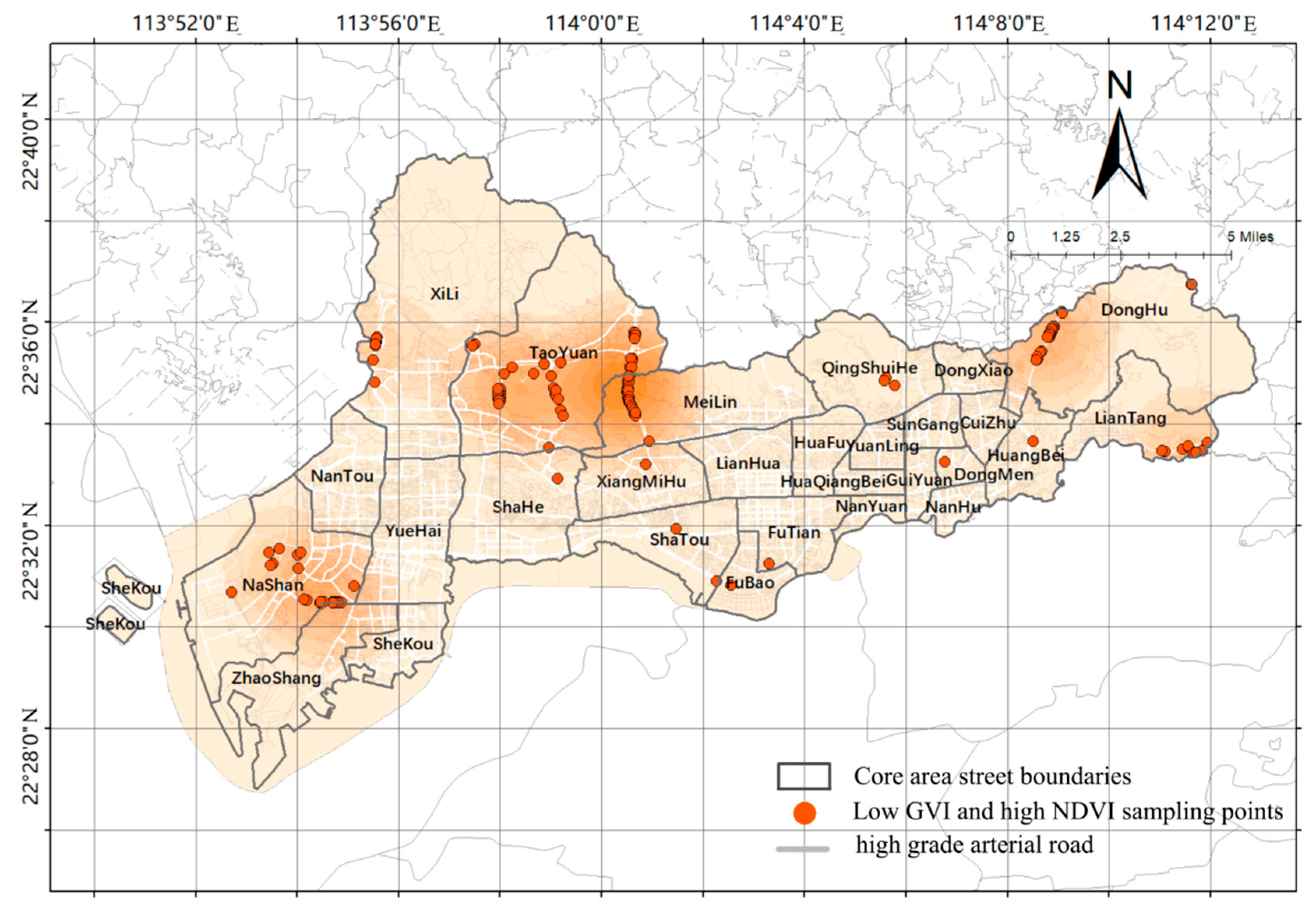


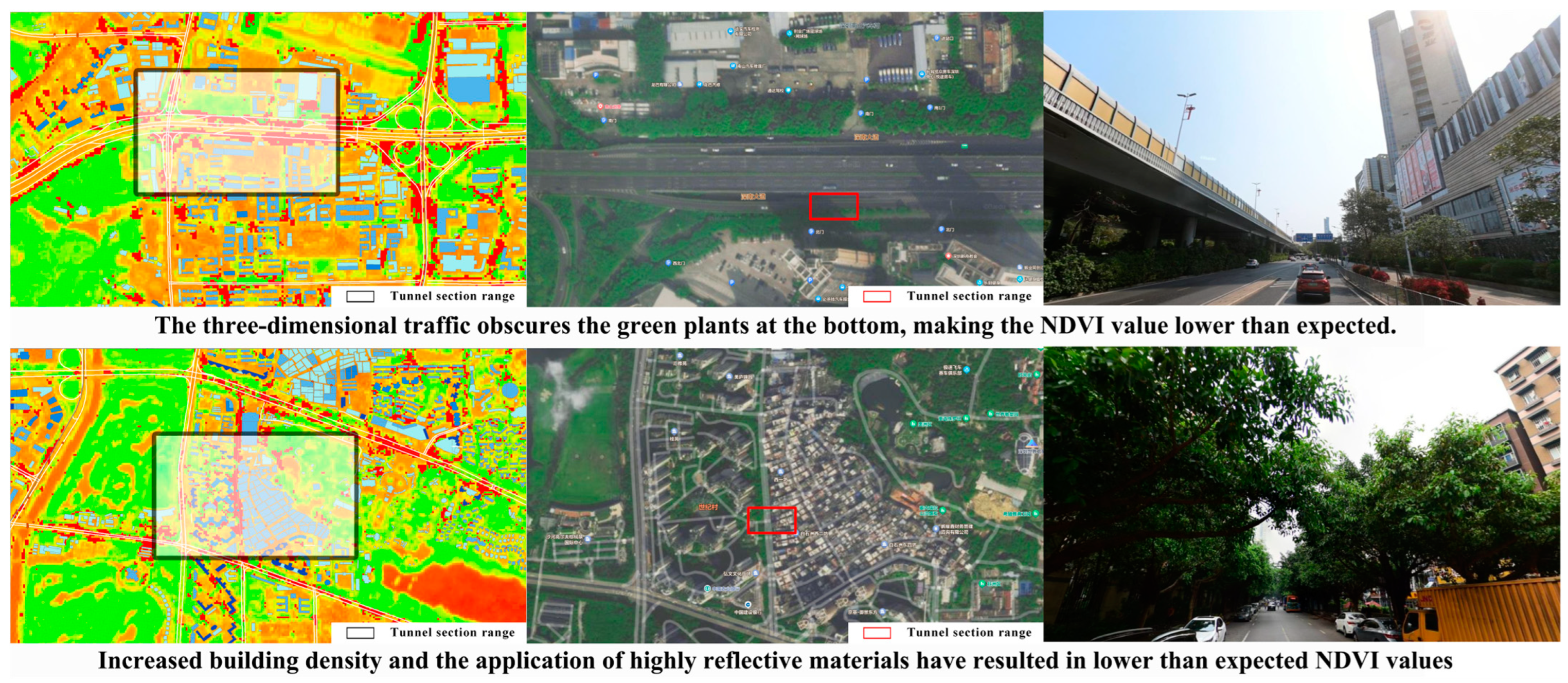
| Climate Elements | Natural Vegetation Types | Land Use Information | |||
|---|---|---|---|---|---|
| Average temperature (°C) | 23.3 | Percentage of subtropical and tropical evergreen broad-leaved and deciduous broad-leaved shrubs (%) | 64.59% | Cultivated land (%) | 5.95% |
| Relative humidity (%) | 74 | Percentage of tropical mangroves (%) | 0.78% | Forest land (%) | 29.14% |
| Precipitation (mm) | 1932.9 | Percentage of cultivated vegetation (artificial turf, artificial forests) (%) | 25.29% | Grassland (%) | 1.23% |
| Sunshine hours (h) | 1853.0 | Percentage of subtropical coniferous forests (%) | 8.56% | Water area (%) | 3.95% |
| High temperature days (d) | 4.4 | Percentage of subtropical and tropical grasses (%) | 0.78% | Urban construction land (%) | 59.73% |
| Land Type Ratio | Shenzhen | Nanshan | Futian | Luohu |
|---|---|---|---|---|
| Arable land (%) | 5.95 | 8.77 | 0.76 | 4.73 |
| Woodland (%) | 29.14 | 24.63 | 18.06 | 49.10 |
| Grassland (%) | 1.23 | 1.86 | 0.24 | 1.03 |
| Waters (%) | 3.95 | 3.05 | 4.21 | 5.64 |
| Urban construction land (%) | 59.73 | 61.70 | 76.73 | 39.50 |
| No. | Data Name | Data Source |
|---|---|---|
| 1 | Population data | Shenzhen Statistical Yearbook 2023 [27] |
| 2 | GDP data | Shenzhen Statistical Yearbook 2023 [27] |
| 3 | Urbanization rate data | Shenzhen Statistics Bureau |
| 4 | Climate element information | Shenzhen Statistics Bureau |
| 5 | Natural vegetation type | “1:1,000,000” China Vegetation Atlas |
| 6 | Land use information | Chinese Academy of Sciences Resource and Environmental Science Data Center |
| 7 | Administrative division | Open Street Map |
| 8 | Road information | Open Street Map |
| 9 | Panoramic static image | Baidu Map Open Platform |
| 10 | Normalized difference vegetation index | Google Earth Engine |
| Number | Semantic Segmentation Categories | 10 | Terrain |
|---|---|---|---|
| 1 | road | 11 | sky |
| 2 | sidewalk | 12 | person |
| 3 | building | 13 | rider |
| 4 | wall | 14 | car |
| 5 | fence | 15 | truck |
| 6 | pole | 16 | bus |
| 7 | traffic light | 17 | train |
| 8 | traffic sign | 18 | motorcycle |
| 9 | vegetation | 19 | bicycle |
| District | Number of Sampling Points | GVI | ||||
|---|---|---|---|---|---|---|
| Mean | Median | Std | Max | Min | ||
| Nanshan District | 5427 | 26.052504 | 20.763597 | 20.210768 | 95.885968 | 0 |
| Futian District | 4283 | 25.815859 | 20.475361 | 19.893862 | 87.554387 | 0 |
| Luohu District | 2544 | 26.505979 | 20.303072 | 22.538585 | 93.763146 | 0 |
| GVI Is Higher | GVI Is Lower | |
|---|---|---|
| NDVI is higher | 495 | 133 |
| NDVI is lower | 179 | 2327 |
| Semantic Segmentation Categories | Correlation Value with Vegetation |
|---|---|
| Road | 0.227 |
| Building (wall + building) | −0.418 |
| Sky | 0.285 |
Disclaimer/Publisher’s Note: The statements, opinions and data contained in all publications are solely those of the individual author(s) and contributor(s) and not of MDPI and/or the editor(s). MDPI and/or the editor(s) disclaim responsibility for any injury to people or property resulting from any ideas, methods, instructions or products referred to in the content. |
© 2024 by the authors. Licensee MDPI, Basel, Switzerland. This article is an open access article distributed under the terms and conditions of the Creative Commons Attribution (CC BY) license (https://creativecommons.org/licenses/by/4.0/).
Share and Cite
Jing, X.; Li, Z.; Chen, H.; Zhang, C. “Is What We See Always Real?” A Comparative Study of Two-Dimensional and Three-Dimensional Urban Green Spaces: The Case of Shenzhen’s Central District. Forests 2024, 15, 983. https://doi.org/10.3390/f15060983
Jing X, Li Z, Chen H, Zhang C. “Is What We See Always Real?” A Comparative Study of Two-Dimensional and Three-Dimensional Urban Green Spaces: The Case of Shenzhen’s Central District. Forests. 2024; 15(6):983. https://doi.org/10.3390/f15060983
Chicago/Turabian StyleJing, Xiang, Zheng Li, Hongsheng Chen, and Chuan Zhang. 2024. "“Is What We See Always Real?” A Comparative Study of Two-Dimensional and Three-Dimensional Urban Green Spaces: The Case of Shenzhen’s Central District" Forests 15, no. 6: 983. https://doi.org/10.3390/f15060983
APA StyleJing, X., Li, Z., Chen, H., & Zhang, C. (2024). “Is What We See Always Real?” A Comparative Study of Two-Dimensional and Three-Dimensional Urban Green Spaces: The Case of Shenzhen’s Central District. Forests, 15(6), 983. https://doi.org/10.3390/f15060983





